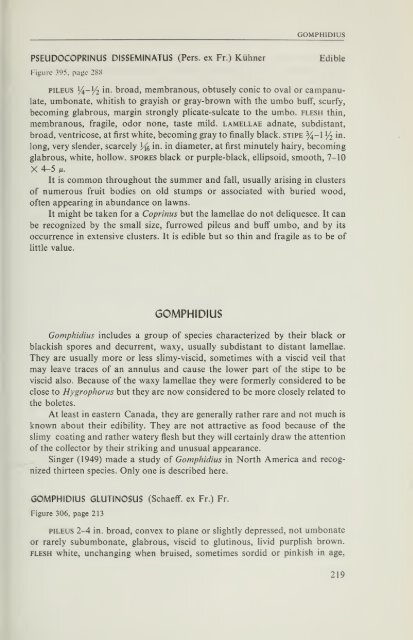You also want an ePaper? Increase the reach of your titles
YUMPU automatically turns print PDFs into web optimized ePapers that Google loves.
GOMPHIDIUS<br />
PSEUDOCOPRINUS DISSEMINATUS (Pers. ex Fr.) Kuhner Edible<br />
Figure 395, page 288<br />
piLEUS 14-/4 ini- broad, membranous, obtusely conic to oval or campanu-<br />
late, umbonate, whitish to grayish or gray-brown with the umbo buff, scurfy,<br />
becoming glabrous, margin strongly pHcate-sulcate to the umbo, flesh thin,<br />
membranous, fragile, odor none, taste mild, lamellae adnate, subdistant,<br />
broad, ventricose, at first white, becoming gray to finally black, stipe %-1 I/2 in.<br />
long, very slender, scarcely }/(^ in. in diameter, at first minutely hairy, becoming<br />
glabrous, white, hollow, spores black or purple-black, eUipsoid, smooth, 7-10<br />
X 4-5 fi.<br />
It is common throughout the summer and fall, usually arising in clusters<br />
of numerous fruit bodies on old stumps or associated with buried wood,<br />
often appearing in abundance on lawns.<br />
It might be taken for a Coprinus but the lamellae do not deliquesce. It can<br />
be recognized by the small size, furrowed pileus and buff umbo, and by its<br />
occurrence in extensive clusters. It is edible but so thin and fragile as to be of<br />
Httle value.<br />
GOMPHIDIUS<br />
Gomphidius includes a group of species characterized by their black or<br />
blackish spores and decurrent, waxy, usually subdistant to distant lamellae.<br />
They are usually more or less slimy-viscid, sometimes with a viscid veil that<br />
may leave traces of an annulus and cause the lower part of the stipe to be<br />
viscid also. Because of the waxy lamellae they were formerly considered to be<br />
close to Hygrophorus but they are now considered to be more closely related to<br />
the boletes.<br />
At least in eastern Canada, they are generally rather rare and not much is<br />
known about their edibility. They are not attractive as food because of the<br />
shmy coating and rather watery flesh but they will certainly draw the attention<br />
of the collector by their striking and unusual appearance.<br />
Singer (1949) made a study of Gomphidius in North America and recog-<br />
nized thirteen species. Only one is described here.<br />
GOMPHIDIUS GLUTINOSUS (Schaeff. ex Fr.) Fr.<br />
Figure 306, page 213<br />
PILEUS 2-4 in. broad, convex to plane or slightly depressed, not umbonate<br />
or rarely subumbonate, glabrous, viscid to glutinous, livid purplish brown.<br />
FLESH white, unchanging when bruised, sometimes sordid or pinkish in age,<br />
219

















